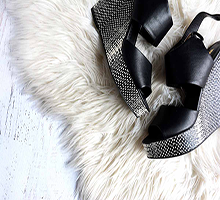
Article Detail
20 Jan
Diabetes and Common Foot Problems
Diabetic patients, having higher level of glucose (sugar) in their blood for a long time can cause some serious health issues, including foot problems.
How Can Diabetes Affect Your Feet?
Diabetes can cause two major problems that can affect your feet:
Diabetic neuropathy: Uncontrolled diabetes can damage your nerves system. If you have damaged nerves in your legs and feet, you might not feel heat, cold, or pain. This is called "sensory diabetic neuropathy." If you do not feel a cut or sore on your foot because of neuropathy, the cut could get worse and become infected. The muscles of the foot may not function properly, because the nerves that make the muscles work are damaged. This could cause the foot to not align properly and create too much pressure in one area of the foot. It is estimated that up to 10% of diabetic patients will develop foot ulcers. Foot ulcers occur because of nerve damage and peripheral vascular disease. Use Micro Cellular Rubber (MCR) footwear or Micro Cellular Polymer (MCP) footwear to prevent diabetic neuropathy.
Peripheral vascular disease: Diabetes also affects the flow of blood. Without good blood flow, it takes longer for a sore or cut to heal. Poor blood flow in the arms and legs is called "peripheral vascular disease." Peripheral vascular disease is a circulation disorder that affects blood vessels away from the heart. If you have an infection that will not heal because of poor blood flow, you are at risk for developing ulcers or the death of tissue due to a lack of blood. Use cushioned pads and insoles in your shoes or use MCR/MCP footwear.
Other Common Foot Problems with Diabetes:
Anyone can get the foot problems listed below. For people with diabetes, however, these common foot problems can possibly lead to infection and serious health issues such as
Athlete's foot is a fungus that causes itching, redness, and cracking. Germs can enter through the cracks in your skin and cause an infection. Medicines that kill the fungus are used to treat athlete's foot. These medicines may be pills and/or creams applied directly to the problem area. Athlete patients should use Micro Cellular Rubber (MCR) footwear or Micro Cellular Polymer (MCP) footwear.
Calluses is a build-up of hard skin, usually on the underside of the foot. Calluses are caused by an uneven distribution of weight, generally on the bottom of the forefoot or heel. Calluses also can be caused by improperly fitting shoes or by a skin abnormality. Keep in mind that some degree of callus formation on the sole of the foot is normal. Proper care is necessary if you have a callus. After your bath or shower, use a pumice stone to gently remove the build-up of tissue. Use cushioned pads and insoles in your shoes or use MCR/MCP footwear. Medications also may be prescribed to soften calluses. DO NOT try to cut the callus or remove it with a sharp object
Corn is a build-up of hard skin near a bony area of a toe or between toes. Corns may be the result of pressure from shoes that rub against the toes or cause friction between the toes. Proper care is necessary if you have a corn - use cushioned pads and insoles in your shoes or use MCR/MCP footwear. After your bath or shower, use a pumice stone to gently remove the build-up of tissue. Do not use over-the-counter remedies to dissolve corns. DO NOT try to cut the corn or remove it with a sharp object.
Blisters can form when your shoes rub the same spot on your foot. Wearing shoes that do not fit properly or wearing shoes without socks can cause blisters, which can become infected. When treating blisters, it's important not to "pop" them. The skin covering the blister helps protect it from infection. Use an antibacterial cream and clean, soft bandages to help protect the skin and prevent infection. Also, use cushioned pads and insoles in your shoes or use MCR/MCP footwear.
Bunion forms when your big toe angles in toward the second toe. Often, the spot where your big toe joins the rest of the foot becomes red and callused. This area also may begin to stick out and become hard. Bunions can form on one or both feet. They may run in the family, but most often are caused by wearing high-heeled shoes with narrow toes. These shoes put pressure on the big toe, pushing it toward the second toe. The use of cushioned pads and insoles in your shoes or use MCR/MCP footwear may help protect the bunion from irritation.
Hammertoe is a toe that is bent because of a weakened muscle. The weakened muscle makes the tendons shorter, causing the toes to curl under the feet. Hammertoes can run in families. They can also be cause by shoes that are too short. Hammertoes can cause problems with walking and can lead to other foot problems, such as blisters, calluses, and sores. The use of cushioned pads and insoles in your shoes or use MCR/MCP footwear may help protect the hammertoe from irritation.
Preventive procedures
Along with treating diabetic foot conditions, there are other things we can do to prevent further problems. If you’ve had foot or vascular surgery to correct a problem, we’ll monitor you over the months and years after.
If we determine at some point down the road that there’s a new area of pressure developing, we may be able to correct it before it becomes a problem. Surgical examples include tendon lengthening or osteotomy, in which we cut or reshape a bone to relieve pressure.
We also may be able to avoid surgery with a non-invasive procedure. If, for example, you have hammertoe, in which the toe bends downward causing repeated ulcers on the tip of the toe, we could perform a percutaneous needle tenotomy. In this procedure, we use a needle to release part of the tendon from the bone.
Diabetes care doesn’t stop at controlling blood sugar. If you or a loved one has diabetes, get in the habit of practicing proper foot care, scheduling regular check-ups and seeking early treatment for problems to prevent serious diabetic foot complications, including amputation.
Last but not the least, use MCR footwear to prevent your feet from all the above foot problems.
Diabetic Foot Care Tips:
- Diabetic patients need to care their feet daily
- Avoid using Pointed Shoes
- Its Important to check is there any Cut or Infection on daily basis
- Avoid using Hot waters to wash your feet will damage your skin, Safe hot water level should be 32 degree C to 35 degree C
- Dry your feet well using a soft cloth
- Apply soft lotion top and bottom of feet to keep the skin soft.
- Avoid using Heating pads
- Keep your blood glucose level targeted range
- Use MCR Footwear/Slippers or Chappals or Sandals and Diabetic Shoes to take care of your feet.
How to Right Choose Diabetic Shoes or MCR Based Shoes
- Buy Shoes with Flat Toe, Avoid Narrow Toe
- Choose Shoes with Padding collar, This will help to prevent the friction and secure your foot.
- Productive Toe area
- Build in Heel counter for Stability
Cromostyle.com MCR and MCP footwear’s are made of premium quality Micro Cellular Rubber and Micro Cellular Polymer, which will help diabetic patients to prevent from diabetic neuropathy, peripheral vascular disease and other diabetic foot problems. MCR Slippers and Shoes are ideal for Heel Pain, Back Pain, Knee Pain and Leg Pain.
Our products are scientifically designed, Unique, Soft, Flexible and provides extra comfort for your feet. Benefits of our product will provides to diabetes patients, including many of who suffer from poor blood circulation in their feet.
Shop online diabetic walking shoes for men and women
Shop online diabetic formal shoes for men
Shop online diabetic slippers for men and women



